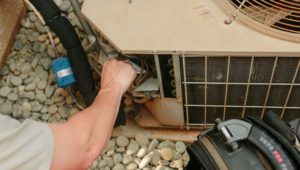During the summer of 2013, I got a service call about some supply AC registers sweating or forming condensation on them. It caught me off guard because the Sacramento Valley summertime conditions don’t usually allow for sweating ducts and registers. In this blog, let’s go over some facts, opinions, diagnoses, and solutions to sweating ducts and registers.
If this is your first time watching our videos, please click subscribe down here on the bottom right, and if you click that little bell next to it, you’ll be notified of all of our videos as they come out.
A quick explanation of what causes sweat or condensation on ducts and registers:
It all comes down to the dew point of the air surrounding the surface forming condensation on it.
Facts
Air is a gas. And that air needs to be cooled to a certain point to achieve 100% humidity. At 100% humidity, air cannot hold more moisture in the gas form, so it becomes liquid…condensation. What is the temperature of the air in that room, supply duct, or the ceiling register that 100% humidity occurs? That’s the “dew point.”

The National Weather Service says, “The higher the dew point
rises, the greater the amount of moisture in the air. That directly affects how
comfortable it will feel”.


“Many times, relative humidity can be misleading. For example, a temperature of 30°F and a dew point of 30°F will give you a relative humidity of 100%. Still, a temperature of 80°F and a dew point of 60°F produces a relative humidity of 50%. It would feel much more “humid” on the 80-degree day with 50% relative humidity than on the 30-degree day with 100% relative humidity. That’s because of the higher dew point.”
We are more “comfortable” during the summer when the dew point is 55°F and less. At 55° to 65°F, the air in your house starts to feel “sticky” or “muggy.” And a dew point above 65°F becomes downright oppressive. The higher the dew point, the less comfortable the conditions are.
So now we can talk about your sweaty ducts and registers.
The house cools down when the air conditioning has been on for a while. But the duct that the air travels through gets cold too. The metal register that the air comes out of gets cold too. There’s even a metal box sometimes called a boot, c-box, b-box, or just a can, that connects the air duct to the metal register that the air comes out of in your room.
Water vapor loves cold metal and other surfaces because the dew point of the surrounding air allows condensation to develop on them. Like a cold glass of water does.
And the longer the air conditioner pushes cold air out of the ducts in an environment where the surrounding dew point is higher, the more sweat will form on the surface of it.
And just to add to the nuisance of condensation, water on those cold surfaces can start to grow mold and bacteria. It can also cause the paint on the metal registers to rust and chip. And if this is going on inside your ducts in the attic or basement, you may not even recognize it because you can see inside them without tearing into the duct or running a camera scope inside them.
Diagnosing
A lot of contractors and their salespeople will suggest adding more insulation to the attic. Or, they’ll say getting new ducts with thicker insulation will solve the problem. But you could add several feet of insulation, but if the outer lining of the duct is cooler than the air around it and it reaches the dew point, condensation is still going to form on the duct. So, adding insulation isn’t always the solution.
Allison Bailes at Energy Vanguard wrote a great article that asked, “How do you tell which is the culprit? Is the dew point too high or the supply vent too cold? The special number here is 55° F. Well, it’s special if you keep your house a 75° F for the indoor temperature and 50% relative humidity. Those conditions correspond to a dew point of 55° F, our special number.”
The higher the relative humidity surrounding your problem surface (the duct or the register), “the higher the dew point is at a given temperature. That means you’re more likely to get condensation because the supply vent doesn’t have to be as cold. For example, at a temperature of 75° F and relative humidity of 60%, the dew point will be 60° F. A supply vent at a temperature of 60° F or below will sweat in that case.”
There’s a Dew Point Calculator website that lets you play around with temperatures and humidity levels to determine the dew point. Like in my house, it’s not unusual to keep my house at 70°. And because the humidity level in my Sacramento house is usually around the 40% area, my AC registers won’t start forming water until the temperature of the metal register goes below 44 degrees…the dew point.
Solutions
The obvious solution to this is buying a ventilating dehumidifier. This helps even when the AC is not running! Whether the AC is operating or not, running a dehumidifier is great for when the AC cools the house fine but doesn’t reduce the humidity enough.

Energy Recovery Ventilators (ERVs), Heat Recovery Ventilators (HRVs), and whole-house fans actually bring in humidity from the outdoors.
Running bathroom fans or laundry fans is a common thought to remove moisture from the room. Some people say these fans remove the humidity, while others say (like a whole house fan does) they bring in air from the outside, which carries humidity with it.
Blower Fan speed – When your installer sets the blower speed on your fancy new system, they’re doing their job right. Not every installer does this. They take a temp split and call it good. But every air handler manual has specific blower settings for each ductwork and static pressure situation.
If you have humidity issues in the house and the tech is waffling on setting the speed one dipswitch higher or lower to match the compressor speed and static pressure, always choose a little lower. While cooling the house faster, high airflow doesn’t allow the evaporator coil to collect enough condensation. A wet evaporator coil means better humidity removal.
Some other issues could be:
One duct laying on top of another can increase the potential for sweating, so separating the ducts will help.
If you routinely keep it like a meat locker in your house, say 62°F, but the relative humidity inside your home is in the high 50s, you will start to have registers that form moisture on them because it’s very likely that your registers will get colder than 46°F which is the dew point at that time
Remember, air conditioning systems usually blow air out of your registers 18 to 22 degrees colder than the air going in. Of course, keeping the house at 62° can cause more issues than that. Evaporator coil freezing is very likely at that point too. And then you start to have mechanical problems that gets really expensive.
Manual Zr says supply air should not drop below 45 degrees for compressor reliability but also influences duct condensation. Besides setting your thermostat too low, other reasons for low supply air temperature are dirty filters, dirty coils, closed registers, kinks in the ductwork, restricted ducting with high static pressure, and improper airflow commissioning where the installer didn’t set the blower to the right speed.
Even the way the duct is attached to the boot/c-box can influence the air stream as it leaves the registers. A duct that heads straight into the boot will likely flow evenly through all the vanes of the registers. But a duct that kinks in sideways or doesn’t have an (insulated) hard 90-degree elbow to direct the air stream properly can cause eddies making that particular part of the boot colder than other edges of it.
Negative pressures within these eddies can even pull warmer room air into the can, intensifying the potential of forming that condensation. That’s why this can happen in more humid rooms of the house like bathrooms and laundry rooms.
When you have registers or the cans they’re attached to, sweating, you have to start eliminating air leaks:
Tape and seal the c-boxes to the sheetrock (or wood flooring if the registers are on the ground.) The ducts that take off from the plenum at the furnace should be sealed around the start collar. There’s duct sealant that is great for that.

The reason behind this is, again, trying to keep the boot or register from getting colder than the dew point surrounding the metal.
Another way to prevent AC registers sweating or from condensation from forming on the registers and ducts is by insulating the inside of the can. This way, you’re keeping the metal of the can from getting too cold.
I’m hoping this helps with your question about why ducts and supply registers in the home form condensation on them. It all comes down to the dew point of the air surrounding the surface, forming the moisture.
References used:
National Weather Service quote https://www.weather.gov/arx/why_dewpoint_vs_humidity
Allison Bailes https://www.energyvanguard.com/blog/why-do-air-conditioning-vents-sweat/























